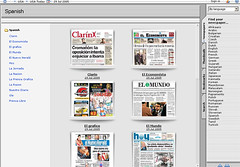Adam Weinroth ha publicado una excelente entrevista a Jon Lebkowsky y Clay Shirky para conocer su opinión acerca de algunas cuestiones relativas al tagging y a las folksonomías.
Shirky hace hincapié en lo que supuso la invención de la imprenta y la necesidad de contar con sistemas de organización y clasificación de todo ese conocimiento que se iba generando en un tiempo menor al que se invertía en su lectura:
Gutenberg’s invention of movable type gave us a world where a book could be created in less time than it took to read it. From the resulting explosion of books came the need to organize them systematically, and the categorization systems that were developed in response — Dewey Decimal and the Library of Congress are the two most familiar — were built around exact location because books _have_ an exact location, as all physical objects do.
Los nuevos modos de creación y utilización de los documentos, el formato electrónico, posibilita además que la información se archive de manera ubicua:
[...] Now we have data that does not have an exact location, or, rather, can have multiple exact locations, and it would be stupid to persist in applying old tools to the current world. Arguing that we should give up on non-hierarchal organization because all the systems we developed for the physical world use it is like the RIAA arguing that because music used to be expensive and inefficient to distribute, it should always remain so.[...]
Lebkowsky confía en las posibilidades del tagging social y augura una mejora en los sistemas de etiquetado que nos ayuden en nuestros buceos por la red:
I think we’ll see more and more ways to use tags, and more (and more manageable) ways to sort and filter those tags and the resources they reference. I think of tags as another good way to surf the web, though, rather than a way to find specific content. We’ll use our increasingly sophisticated search engines for that.
Tanto Shirky como Lebkowsky vaticinan en qué ámbitos y proyectos el tagging y las folksonomías triunfarán y tendrán una mayor incidencia. Shirky apuesta por los mapas y señala algunos ejemplos ya disponible en la red:
There are so many cool ‘tag this location’ efforts going on it’s hard to keep track of them — Platial, FoundCity, Tagzania, and so on. All these efforts take the basic intuition of tagging — URLs are a good thing to attach labels to — and applies it to the map world — locations are a good thing to attach labels to. And because tagging is so flexible, the services can be used for everything from restaurant recommendations to art walks to city guides for tourists or new arrivals. A year from now there will be an astonishing amount of value being created by tagging maps. Two years from now we’ll all be shaking our heads wondering how we could have lived without that function. Three years from now, we won’t remember a time when you couldn’t tag maps.
Lebkowsky alaba el uso del etiquetado de restaurantes o el aprovechamiento del tagging en temas de visualización de información:
I think Dinnerbuzz is a cool idea a restaurant review multiblog with tags. Shadows lets you tag pages but theres more each page thats tag has a shadow page where users can post comments and discussion. (The sample page they show isnt very inspiring, but I like the idea.) Tagifieds is a tag-based bulletin board. And theres Wists, the visual bookmarking system which allows you to nab an image from the site as part of your bookmark.






Comentarios recientes